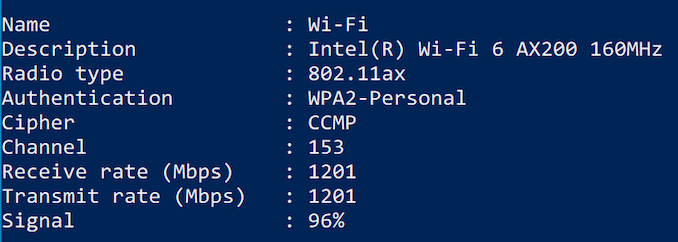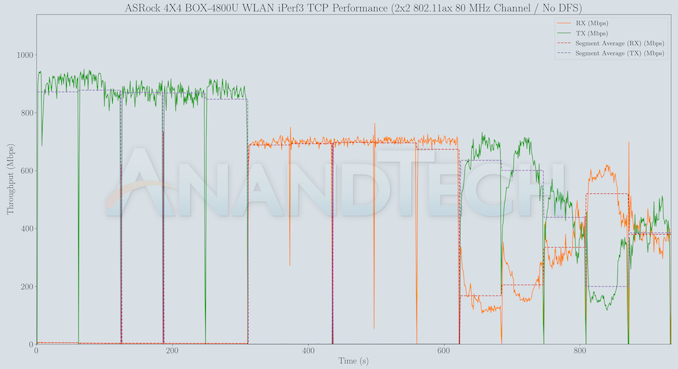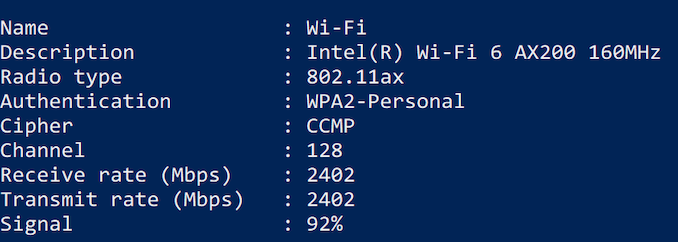ASRock Brings Zen 2 NUC : 4X4 BOX-4800U Renoir Mini-PC Reviewed
by Ganesh T S on November 25, 2020 11:00 AM ESTStorage and Networking Performance
Storage and networking are two major aspects which influence our experience with any computing system. This section presents results from our evaluation of these aspects in the ASRock 4X4 BOX-4800U. On the storage side, one option would be repetition of our strenuous SSD review tests on the drive(s) in the PC. Fortunately, to avoid that overkill, PCMark 8 has a storage bench where certain common workloads such as loading games and document processing are replayed on the target drive. Results are presented in two forms, one being a benchmark number and the other, a bandwidth figure. We ran the PCMark 8 storage bench on selected PCs and the results are presented below.


The 1TB Crucial P5 SSD in the Frost Canyon NUC manages to provide higher storage bandwidth compared to the 512GB DRAM-less Patriot P300 in the 4X4 BOX-4800U, but the storage subsystem scores are fairly close to each other.
On the networking side, we restricted ourselves to the evaluation of the WLAN component. Our standard test router is the Netgear Nighthawk AX12 RAX120 configured with both 2.4 GHz and 5 GHz networks. The router is placed approximately 11 ft. away with a direct line-of-sight to the PC under test. A wired client (Zotac MI553, with an Akitio T3-10G NBASE-T Thunderbolt 3 adapter) is connected to the 5GbE port of the RAX120 and serves as one endpoint for iperf evaluation.
We first left the 5GHz network at default (meaning, no DFS), and the 4X4 BOX-4800U connected with the following parameters,
A script to run iPerf3 with 1, 2, 4, 8, and 16 parallel streams between the 4X4 BOX-4800U and the Zotac ZBOX MI553 was processed - the first set for TX alone, followed by another set for RX, and finally a third set with bidirectional traffic.
The RAX120 can be explicitly configured to connect over a DFS channel. This works in the absence of any radar presence in the vicinity. In such a scenario, the 4X4 BOX-4800U connected with the following parameters,
The iPerf3 script was processed again and delivered the following result.
With DFS support, we can expected around 1.28 Gbps of best-case throughput via the AX200 in the 4X4 BOX-4800U. The table below presents the iPerf3 benchmark results obtained in the above testing scenario.
| Wireless Bandwidth - TCP Traffic (iPerf3 Throughput in Gbps) |
||||
| Stream Count |
80 MHz Wi-Fi 6 (Non-DFS) | 160 MHz Wi-Fi 6 (DFS) | ||
| TX | RX | TX | RX | |
| 1 | 0.897 | - | 1.259 | - |
| 2 | 0.893 | - | 1.242 | - |
| 4 | 0.868 | - | 1.286 | - |
| 8 | 0.862 | - | 1.299 | - |
| 16 | 0.876 | - | 1.294 | - |
| 1 | - | 0.695 | - | 0.908 |
| 2 | - | 0.697 | - | 1.027 |
| 4 | - | 0.698 | - | 1.154 |
| 8 | - | 0.701 | - | 1.211 |
| 16 | - | 0.701 | - | 1.262 |
| 1 | 0.652 | 0.153 | 1.183 | 0.045 |
| 2 | 0.612 | 0.208 | 1.020 | 0.185 |
| 4 | 0.451 | 0.342 | 1.089 | 0.152 |
| 8 | 0.207 | 0.541 | 0.940 | 0.298 |
| 16 | 0.403 | 0.383 | 0.815 | 0.421 |
The numbers presented above are slightly lesser than the average segment bandwidths noted, as the data in the graph is computed from the network interface's counters, while iPerf reports results based only on the traffic sent by it alone.














53 Comments
View All Comments
redwingsbb - Saturday, November 28, 2020 - link
I don't think spikebike was saying that they would wait 2 years to buy I think they were saying it would be interesting to wait until CES in a couple of months to see whether there could be Zen 3 based NUC coming out in the next few months which in their opinion would be a big enough upgrade over a Ryzen 4000 based NUC to last them a full year or two longer.ifThenError - Monday, November 30, 2020 - link
You are very right, Zen3 in a small form factor would be a formidable plattform for many use cases. I'd happily swap my old box for such a device.Unfortunately I wouldn't expect this to happen anytime soon. Currently there is no such thing as a Zen3 based APU. The Zen2 based Renoir has just been released and still seems to have limited availability. It is more than a year behind the desktop and server Zen2 chips. Even if a Zen3 mobile chip was anounced in January, we would probably still be at least a year away from any SFF using it.
Looks like the devices from Asus and ASRock are your best bet, or you need a lot of patience.
Valantar - Thursday, November 26, 2020 - link
Pretty damn impressive seeing this hit above 1300 in Time Spy and nearly 14000 in night raid. My ITX 4650G with the iGPU@2100, RAM @3800c16 and IF@1900 hits >1600 TS and >17000 NR, but that also consumes ~100W from the wall. With this sitting in the 50s of watts except for initial spikes, that's very good performance for the tiny power draw.Really looking forward to how boxes like this evolve with DDR5.
Oh, and the dual NICs are brilliant. The 4350G version of this would make for a great PFSense box.
DanaGoyette - Thursday, November 26, 2020 - link
Realtek Virtual IPMI, on the Platform Analysis page....huh, does this have out-of-band management capabilities? If so, it could be useful as a server.
ganeshts - Thursday, November 26, 2020 - link
Yes, the 1G port has Realtek DASH enabled. I am actually investigating that feature right now (couldn't complete it in time for publishing the review), but information / guides are hard to come by. Realtek's own software that talks to DASH clients is a mess / very user unfriendly.watersb - Saturday, December 19, 2020 - link
And here (for reference) is the DASH overview article. Excellent!https://www.anandtech.com/show/16319/asrock-4x4-bo...
zakelwe - Friday, November 27, 2020 - link
Who cares about this? Where are the graphics card reviews from Amd and nVidia ?abufrejoval - Friday, November 27, 2020 - link
I had ordered the PN50 in summer with the Ryzen 4800U when a major EU retailer promised only 2-3 days deliver delays. Alas, the only thing that moved was the delivery delay, which increased and wound up as unknown. The Ryzen 4800U SoCs requires perfectly binned Renoir chips and those are likely to remain rare even while they are being replaced by 5800U chips (eve more attractive and harder to get?).I had to resort to team blue, which has some advantages in my KVM live-migration scenarios and could become especially interesting: if I can get Thunderbolt 40Gbit networking to work, I’d use that for the cluster/gluster interconnect and switch the USB 2.5Gbit NICs to the front-end. ASRock is doing the right thing here, I wish 2.5Gbit had long since become default everywhere, especially since I can’t believe Realtek charges more than a few cents extra for the speed uplift.
In the mean-time I’d just like to report that the NUC8i7BEH has had its price reduced to around €300 including EU VAT, while the BXNUC10I7FNH currently goes for €450. That comes down to €75/core and pretty much to core/€ parity with the 4800H at €600, which is why I got one of each in the end. Their combined idle power may actually not be higher than the AMD unit, while peak heat and noise are very well managed via OS independent BIOS settings on Intel NUCs these days.
The Bean Canyon’s Iris 655 iGPU main advantage is that it doesn’t cost one cent extra vs the ordinary i7-10700U UHD630, just as the 128MB eDRAM are given away for free and that L4 cache does at least deliver measurable performance advantages to the CPU, even if they aren’t noticeable. Both give an i7-7700K a run for its money on bursty desktop/server workloads, but less so as members of a render or compile farm.
While I’ll use both pretty much only for CentOS/oVirt, I did test them intensively on Windows with all sorts of graphics loads. AT basically infected me with curiosity about these larger Iris iGPUs years ago. 3DMark Night Raid at 1920x1080 IMHO shows their basic potential and why Apple used them as their main staple for a while, but the most impressive demo remains Google Maps with their AI created 3D view in Chrome (much slower in Firefox, unfortunately), which not only runs smoother on my 4k display, than Microsoft’s 2020 FlightSim on my RTX 2080ti/Ryzen 7 5800X game rig, but actually reflects what’s on the ground. FlightSim resorts to pure parametric random algorithms, which create ground structures and traffic patterns that not only carry no resemblance with ground truth, but don’t make sense, even at propeller speeds.
While I would probably still rationally prefer NUC innards as Mini-ITX boards for better options on cooling and general modularity, I’ve come to appreciate those NUCs mostly because the chassis and power supply come basically for free and at excellent build quality, while expansion on mobile SoCs is mostly external anyway.
Gadgety - Saturday, November 28, 2020 - link
Nothing on physical size or noise?Gadgety - Saturday, November 28, 2020 - link
110.0 x 117.5 x 47.85mm